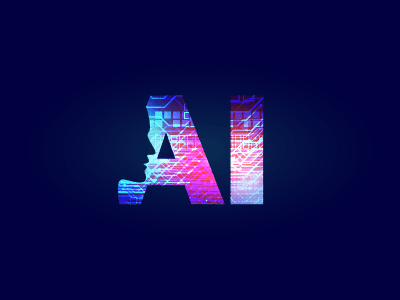Artificial Intelligence is Here with These 5 Products
 Last Moment Tuitions
Last Moment Tuitions
Blog: A blog around AI products available.
Artificial Intelligence is Here with These 5 Products: A blog around AI products available.

~Hey Siri, show me the nearest fast-food restaurant!
…And the assistant will reply with the relevant information by scanning your phone or the web.
This is a very basic example of Artificial Intelligence! Let’s find out more about it!
So, what exactly is AI?
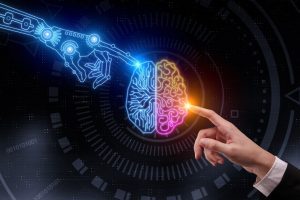 At some point in our lives, we’ve all used Siri, Google Assistant, Cortana, or even Bixby. What exactly are they?
At some point in our lives, we’ve all used Siri, Google Assistant, Cortana, or even Bixby. What exactly are they?
The term “Artificial Intelligence” was coined in the 1950s by John McCarthy. Artificial intelligence is, in its most basic form, a field that combines computer science and robust datasets to solve problems. It also includes the subfields of machine learning and deep learning. These fields are made up of AI algorithms that aim to develop expert systems that make predictions or classifications based on input data.
AI Levels: An Overview
- Narrow AI: A narrow artificial intelligence is one that can execute a single task better than a human.
- General AI: An artificial intelligence achieves general intelligence when it can execute any intellectual task with the same level of precision as a human.
- Strong AI: An AI is strong when it can outperform humans in a variety of activities.
Nowadays, AI is used in almost all industries, providing a technological advantage to all companies that integrate AI on a scale.
According to McKinsey, AI has the potential to generate 600 billion dollars in value in retail. In transportation and logistics, the potential revenue increase is 89 per cent higher. Artificial intelligence AI could be used by banks, retailers, transportation companies, and other industries.
Implementation of AI:
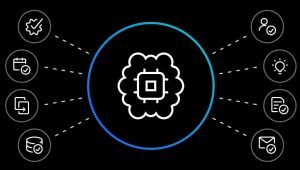 Deduction and reasoning, knowledge representation, planning, natural language processing (NLP), learning, perception, and the ability to manipulate and move things are the major aims of AI.
Deduction and reasoning, knowledge representation, planning, natural language processing (NLP), learning, perception, and the ability to manipulate and move things are the major aims of AI.
The following are the steps taken to create an AI model for a specific purpose:
- Define a Use Case: It’s critical for business leaders and project managers to begin by clearly outlining and explaining the specific problems or challenges that AI can help them solve.
- Verify data availability: The next step is to make sure that the existing procedures and systems are capable of gathering and tracking the data required for the analysis.
- Exploration of basic data: Do a quick data exploration exercise to confirm its data assumptions and understanding. This will assist in determining whether the data is conveying the correct picture based on the company’s subject matter expertise and business acumen.
- Define a model-building methodology: Validating the hypothesis and improving its execution are done by running tests to identify which variables or characteristics are the most important. Business and topic experts should be involved since their continual feedback is critical for validation and ensuring that all stakeholders are on the same page.
- Establish a model validation procedure: The definition of performance metrics will aid in the assessment, comparison, and analysis of outcomes from different algorithms, allowing specialised models to be fine-tuned even further. A training set will be used to train the algorithm, and a test set will be used to assess it. Business and domain experts should be involved to ensure that everything is moving in the right direction.
- Automated production and deployment: The model must then be put into production when it has been created and validated, during which business users may offer ongoing feedback on the model’s behaviour and outcome. To automate data input, the relevant tools and platforms should be chosen, with processes in place to distribute results to the proper audiences.
- Update the model as needed: For a variety of causes, models can become out-of-date. Once a model has been published and deployed for usage, it must be continually monitored since an organisation may change the model as needed by understanding its validity.
Major players in the artificial intelligence market are Google, IBM, Baidu, Microsoft, Apple Inc., NVIDIA Co., Samsung Electronics Co. Ltd. and MicroStrategy Inc.
- For example, Microsoft has invested around $1 billion in OpenAI, a San Francisco-based firm. The two businesses had formed a collaboration to develop AI supercomputing technologies on Microsoft’s cloud Azure.
- According to Gartner, AI use in various industries is accelerating to the point that it will create around 2.3 million employments by 2023.
- Engineers in artificial intelligence must use their mathematical and statistical skills to analyse data, develop models, and manage AI systems. AI processing includes machine learning, deep learning, and natural learning (NLP).
- The starting salary for AI engineers is ₹6,00,000 and may rise to ₹50,00,000 based on experience.
Therefore, rise in investment in AI technologies due to its advantages in every sector is driving the market for the Artificial Intelligence market.
Applications of AI:
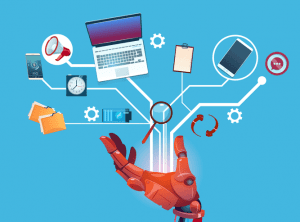
- AI in Healthcare: Healthcare industries are using AI to produce better and faster diagnoses than humans. AI can assist doctors with diagnosis and can alert doctors when patients’ conditions deteriorate, allowing medical assistance to reach the patient before hospitalisation.
- AI in Gaming: AI machines can play strategic games such as chess, in which the system must consider a huge number of possible locations.
- AI in Finance: Automation, chatbots, adaptive intelligence, algorithm trading, and machine learning are all being incorporated into financial operations.
- AI in Data Security: AI can help you protect and safeguard your data. Some examples are the AEG bot and the AI2 Platform, which are used to better detect software bugs and cyber-attacks.
- AI in social media: Facebook, Twitter, and Snapchat, for example, have billions of user accounts that must be kept and maintained in a highly efficient manner
- AI in Robotics: We can use AI to develop intelligent robots that can complete tasks based on their own experiences rather than being pre-programmed.
- AI in Automotive Industry: Some automotive companies are employing AI to give virtual assistants to its users in order to improve performance, and are now working on building self-driving cars that will make your journey safer and more secure. E.g., Tesla.
Machine Do Not Have Emotions.
They don’t have to eat or sleep as we do, and they never get sick or need to consume leaves.
That is why AI has an edge, but first, let’s look at the other side of the coin!
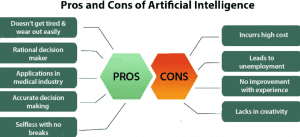
High-tech robots have the potential to harm humanity if AI gets into the wrong hands. You already know from all the many movies you’ve seen on television.
Also, to avoid the risk of machines replacing humans and resulting in loss of jobs. Here are some scenarios to consider too.
Conclusion-
In a nutshell, AI is a cutting-edge technology that allows computers to deal with complicated data that is hard for humans to handle. AI automates repetitive activities, freeing up a worker’s time to focus on higher-level, value-added tasks.
Despite all of the pros and cons of artificial intelligence, industries are adopting AI to do tasks more effectively and at a lower cost. As a result, Artificial Intelligence is developing, it is becoming a future trend.
There’s no denying that machines are more efficient at work, but they can’t replace the human connection, feelings and moral concepts that brings a team together. Humans and machines cannot form a relationship.
As a result, it is better to accept the changes in the society we live in and to take use of all of the wonderful qualities that artificial intelligence has to offer.
Want To Read More About This Discussion?


